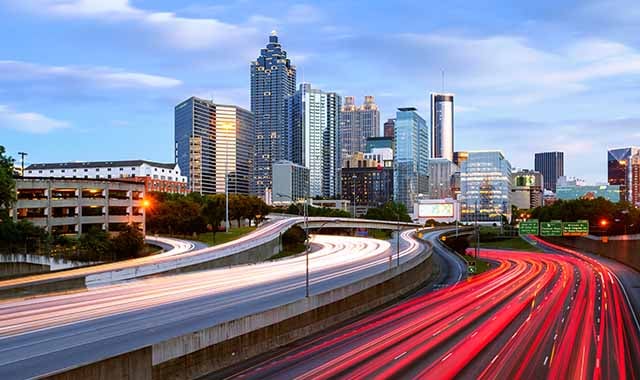Four Components to a Smart City

A “smart city” is more than roads communicating with vehicles to help reduce congestion. It’s much, much more.
Smart cities are responsive, intelligent, connected and sustainable. They’re made up of four main components, and without all four, you can’t have a smart city.
Check out each of the four components and see how they all work together.
Analytics: Putting Data to Work
Data lies at the heart of the smart city.
Rapidly evolving technology and sensors are enabling the concept of a smart city. From the devices in your vehicle to the sensors on traffic signs, there is a giant influx of data being generated and made available. But how do we decipher that data and turn it into something meaningful?
First you must identify the problem you are trying to solve. Fewer pedestrian injuries? Faster response time for emergency vehicles? Then you put the technology in place that can provide data related to the problem. Once you’ve got that data, you need to analyze it.
“There is so much data that is being collected. It can be from and about anything – air, water, vehicles, lights. Then we have to analyze that data in a way that provides value for the citizens, visitors, businesses in these communities. It’s about improving quality of life,” said Dominie Garcia, Senior Market Manager in Battelle’s Transportation business.
Here’s a simple example: smart and connected street lights. If a street light has an embedded sensor the sensor can detect when it’s dark outside, when someone walks by, etc. That data can then be used to automatically turn the sensor on and off based on its environment. In addition, you could add additional sensors collecting different data and adapt utilities or other services accordingly.
Transportation: Smart Transportation Solutions
In the smart city, vehicles, infrastructure, public transit and people all work together as part of a connected transportation system that improves mobility and safety.
Smart transportation systems can be used to combat a number of challenges in a given community, including improving commute times, increasing safety for riders and pedestrians, and offering alternative options for transportation. Some of the technologies that help with these challenges include connected vehicles and electric vehicles.
For example, Battelle has software deployed in Cleveland, Ohio that is helping bus drivers better detect when and where pedestrians are.
“We are able to understand the landscape of a community and can bring some technologies or work with partners who can offer technologies that can help solve these transportation issues,” said Dominie.
Health: Building Healthier Communities
Smart cities are healthy and sustainable.
This means taking a look at the systemic, existing challenges in healthcare, such as access to healthcare, inefficient or ineffective use of emergency facilities and providing healthcare to remote areas.
Work is being done on a number of fronts. There’s an effort with healthcare providers to use the biometric sensors worn every day by many people to help prevent adverse events, such as a diabetic event. There are solutions being developed to address challenges for pregnant women living in disadvantaged communities and how to make it easier – and not more costly – for them to get to prenatal checkups.
There’s also a public health side that can have an impact on public policy. Air quality monitoring devices that can sense things such as allergens or exhaust at a microscopic level can be used to help people plan their days better.
Adding sensors to medical devices, such as inhalers, can provide surprising data. A GPS device on an inhaler could show concentrated areas of breathing problems. If a cause can be determined, a solution might not be far behind.
Environment: Creating Resilient Urban Environments
Innovations helps smart cities stay strong in the face of changing environmental, economic or political conditions.
Much of the effort in this area is about being prepared. You can’t avoid a hurricane or a tornado, but you can change how you respond so that it’s a much more automated, precise reaction.
Sensors in water can help cities better map floodplains. The data collected in sensors from other areas could be used to better predict where major fires are likely to happen – offering an opportunity for proactive prevention.
Sometimes the environment we’re looking at isn’t just the water, air, vegetation in an area – it’s everything around you. For example, on a military base, real-time information is key. Who is coming in and out of the base? Who is on the base at any given moment? How do you distill that information?
Bringing It All Together
Does this help you see how each of these components are necessary to create a truly smart city? How if just one is missing, the concept won’t hold up?
Battelle is working to bring this smart-city vision to life. Our broad range of expertise – from data analytics and public health to transportation system design and emergency management – enables us to find innovative solutions to the complex and interrelated challenges faced by urban communities.
Sign Up for Battelle Updates
Follow along with the latest news, announcements and updates from our Battelle community of solvers.